Top News
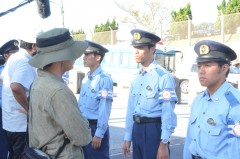
July 25, 2014 Ryukyu Shimpo
An ongoing protest rally against the construction of an alternative base for U.S. Marine Corps Futenma Air Station in Henoko, Nago started at the front of the first gate at Camp Schwab at about 6:00 a.m. on July 25.
Before citizens arrived at the first gate, police officers were standing on the sidewalk to prevent protest action. At the scene, a standoff between the police and citizens continues.
Hiroji Yamashiro, the director of the Okinawa Peace Movement Center, said, “We were trying to stage a sit-in-protest in front of the gate, but we were blocked by the police officers. We will continue our protest rally even though they are interfering with our activity.” The police set up elaborate security in front of the gate from early morning.
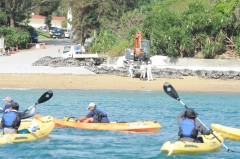
At 9:21 a.m. on July 25, on the bay surrounding Camp Schwab in Henoko, Nago, citizens riding in canoes were yelling in chorus, demanding workers stop the construction of the new base.
Meanwhile, at the beach facing Oura Bay within Camp Schwab, a land leveling operation which began on July 25 resumed at around 9:00 a.m. in order to install a pier. The ground levelling work appears to be almost completed. Construction workers brought six dynamo-electric generators to the scene for the next stage.
On the bay in front of Schwab, citizens riding in canoes raised their voices saying ”Stop the construction!”
(English translation by T&CT)
Go to Japanese
July 23, 2014 Ryukyu Shimpo
At a press conference on July 22, Defense Minister Itsunori Onodera suggested there is a possibility that the U.S. Marines at Futenma Air Station will tentatively use Saga Airport in Saga prefecture to station aircraft. Itsunori said, “This is on the premise that the operation of Futenma base will not stop within five years.” Okinawa Governor Hirokazu Nakaima has previously asked the government to stop the operation of Futenma base within five years.
On the morning of the same day, at Saga Prefectural Government Office, Parliamentary Senior Vice Defense Minister Ryota Takeda met with Governor Yasushi Furukawa to convey the possibility that U.S. Marine’s Osprey aircraft will be tentatively stationed at Saga Airport. The vice minister sought the governor’s approval.
Defense Minister Onodera explained to reporters that the use of Saga Airport by the U.S. Marines instead of Futenma is conditional on there being progress on construction of the Henoko replacement facility. However, the defense minister avoided answering questions regarding whether or not there is a possibility that other aircraft besides the Osprey will be based Saga Airport.
Onodera said, referring to the use of Saga Airport by the U.S. Marines said, “We need to consult with the Saga prefectural government and the U.S. military side.” He did not comment further on this issue. The Okinawa Prefectural Government has requested the central government move the U.S. Marine Osprey training outside of Okinawa. Onodera has since suggested that Saga Airport could be one of the training bases for U.S. Marine Osprey aircraft. In reply to a suggestion from reporters that the relocation site for the Futenma base does not have to be Henoko, the defense minister answered, “The Futenma base must not remain at the current place. It is assumed that we will relocate the Futenma base to Camp Schwab. My request to move the aircraft to Saga Airport is a temporary measure.”
Vice minister Takeda, at meetings with Governor Furukawa, requested permission to deploy to Saga Airport 17 Osprey aircraft, which are to be introduced into the Ground Self-Defense Force. The governor claimed the move was necessary to ensure safety. They agreed to continue consulting on this proposal.
In a press conference after his meeting with the governor, Takeda announced that the Ground Self-Defense Force will deploy its Osprey aircraft to Saga Airport from fiscal 2019, as the Self-Defense Forces are scheduled to introduce the tilt-rotor aircraft. The Defense Ministry plans to make a budgetary request for fiscal 2015 to acquire land adjacent to the airport so that new facilities can be built. In a meeting with the vice defense minister, the governor pointed out, “It is the government’s responsibility to explain to citizens why Saga Airport was chosen, or whether the Osprey is really a safety aircraft. It is necessary to gain an understanding from citizens. At the same time, the government must ensure the safety of people around Saga Airport.” He added, “I have not decided whether I am for or against the proposal. I have to assess it in detail. We will continue to exchange views with the Ministry of Defense.”
In a meeting with the governor, Takeda explained the plan to move about 50 helicopters from the GSDF Camp Metabaru in Yoshinogari in the same prefecture to Saga Airport. He also met with Saga mayor Toshiyuki Hideshima and the chairman of the Saga Prefectural Assembly Hobun Kihara.
(English translation by T&CT)
Go to Japanese

July 18, 2014 Eriko Tamaki of Ryukyu Shimpo
The Himeyuri Peace Museum in Itoman marked its 25th anniversary on June 23rd this year. In March 2014, the total number of visitors over the last 25 years was 19,801,496 people. Many students on school trips and tourists from outside Okinawa visited the museum. The national government during the war made students go to the battlefields. The museum presents war as it is through its exhibition, and tells the stories of the dangers to Okinawan school children during the battle of Okinawa. It also highlights how precious peace is.
In fiscal 2013, 2,242 schools and 317,554 students visited the museum on school trips and the total annual number of visitors was 660,374 people. Although the total annual number of visitors has dropped about 300,000 from a previous spike in visits, it is the biggest number out of all the museums in Okinawa.
Himeyuri Peace Museumi is known above all for its oral-history approach where visitors hear directly from survivors of the war who tell them about their experiences and share their thoughts on peace. Lectures by survivors have been held continuously at the museum for 25 years and their words have aided visitors’ understanding of the museum displays. In the past, a person who intended to commit suicide, listened to war experiences from a former Himeyuri student, and decided not to do so.
Another feature of the museum is that they have never accepted financial support from the Japanese Government or the Okinawa Prefectural Government. By securing money from its alumni association and foundation, they have avoided political interventions to change the exhibitions. They have kept working to pass on war history to the next generations in a consistent way.
The museum, established and maintained by survivors, has held various events since its inauguration. The survivors involved in the museum asked themselves many times how best to describe the nature of war to people. As well as visiting battle sites, they organized the “Exhibition of all students in the Battle of Okinawa” as its 10th anniversary project. For this project, all former students who worked at battlefields in the war, gathered at the museum and female students set up a group called the “Association to Tell Days of Our Youth.”
Since 2000, with many survivors ageing, the museum has been tackling the challenge of how they should hand down their memories of war and the running of the museum to the next generation. They started the “Project for Next Generations” in 2002. Three people who have no experiences of war, have since been telling stories of the Battle of Okinawa to visitors. Also, three curators and six staff members who have not experienced war, have been interviewing survivors and then telling their stories.
Special exhibition starts with new testimonies
On July 18, Himeyuri Peace Museum started a special exhibition for its 25th anniversary entitled “Testifiers of Himeyuri: 25 years to tell the story of the Battle of Okinawa.” For the special exhibition, they filmed new testimonies from survivors and presented them in the exhibition. The film features the period in which the survivors could not tell others their war experiences in the past 25 years since the museum opened. It also screens the survivors’ views on the Constitution’s pacifist Article 9.
Although there have been many records of war experiences, the film is one of the few glimpses into how the survivors felt when they told their stories of war to others. In the last half of the film, the testifiers expressed their wish to hand a peaceful world onto the next generation.
(English translation by T&CT and Lima Tokumori)
Go to Japanese
July 20, 2014 Ryukyu Shimpo
On July 18, the Okinawa Prefectural Government announced the number of tourists who came to Okinawa in June 2014. A total of 557, 300 visitors represents a 13.9 percent increase over the same month last year, setting a new monthly record. This is the first time the number of tourists coming to Okinawa has exceeded 500,000 in June.
As a result, the number of tourists who came to Okinawa has exceeded the previous year’s records for 21 consecutive months since October 2012. The number of foreign tourists increased by 52.8 percent to 95,500. It exceeded 90,000 for two consecutive months.
Although low-cost carriers cut 40 domestic flights to Okinawa in 2014, this did not affect tourism. The same number of seats was filled in flights to Okinawa this June as in June 2013.
The number of foreign tourists traveling by air and sea was high because airline companies expanded routes to Taiwan and China, and many cruise ships visited Okinawa during this period. The figures were new records for three consecutive months.
The total number of domestic tourists visiting Okinawa increased by 8.3 percent to 461,800. Those visiting from Tokyo increased by 7.1 percent to 220,100, from Kansai by 8.6 percent to 100,000, and from Fukuoka by 6.1 percent to 55,700. The number of tourists from Nagoya increased by 3.6 percent to 37,500.
The number of tourists from Taiwan increased by 42.6 percent to 41, 200. Those from Hong Kong increased by 52.7 percent to 13,900. Those visiting from mainland China increased by 2.7 times to 11,800 with 11,400 tourists from Korea, a 78.1 percent increase.
A spokesperson for the Okinawa Prefectural Government said, “The number of tourists to Okinawa exceeded 500,000 in June despite June being in the tourist off- season. Many people have come to recognize Okinawa as a popular tourist spot, which has led to airline companies expanding flight routes.”
(English translation by T&CT)
Go to Japanese
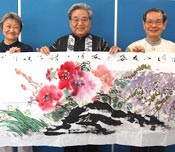
July 21, 2014 Ryukyu Shimpo
Three calligraphers, including Houn Toyohira from Okinawa, have deepened regional ties through a cultural exchange with five artists representing Fujian, China at the Fujian and Okinawa Friendship Hall in Fujian Province, China. The program was held on July 11.
The Fujian Province Government and Okinawa Prefectural Government jointly invested in building the Fujian and Okinawa Friendship Hall in 1998. Recently, the governments have been holding an exchange program through calligraphy at a renewed exhibition space in the hall. Twenty-two people from Okinawa, including Akira Shimoji, an official of the Okinawa Prefectural Government, took part in the event.
Calligraphers Toyohira, Taisui Miyazato and Konan Kosugi took part in the exchange meeting. Fujian and Okinawan artists completed three collaboration works on the spot. These works were exhibited.
Tohoyohira then wrote a calligraphy piece, “Let the flower of friendship between China and Japan bloom forever.” “Only Japanese and Chinese use Kanji. We would like to understand one another through calligraphy more,” he said. Miyazato said, “If we deepen the interchange between citizens of both countries through the culture, we can change dysfunctional aspects of the relationship.” Kosugi added, “We can understand one another through calligraphy.”
(English translation by T&CT)
Go to Japanese
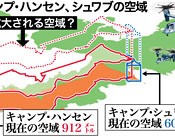
July 17, 2014 Ryota Shimabukuro of Ryukyu Shimpo reports from Washington D.C.
The U.S. Marine Corps plans to raise the vertical limit of the restricted airspace for aircraft training over the Central Training Area in Okinawa. This training area is near Camp Hansen in Kin and Ginoza, and Camp Schwab in Nago. The Marine Corps reported the change in its “2025 Strategic Vision”, published by the Marine Corps Installation Pacific (MCIPAC) last year.
The report says, “MCIPAC will work with the Government of Japan to redesign Special-Use Airspace over the Okinawa Central Training Area to raise the vertical limit of the restricted airspace.” It also stresses, “This will provide additional vertical airspace to contain the ef-fects of small arms training which will allow for improved training.” Currently, the Gov-ernments of Japan and the United States authorise a restricted airspace for U.S. military training of up to 608 meters altitude over Schwab and 912 meters altitude over Hansen.
The report states that sea and air transport capabilities and capacities will be strength-ened through the expansion of Marine Corps Air Station Iwakuni, the modernization of MCAS Kaneohe Bay, Hawaii, the construction of the Futenma replacement facility in Henoko, Nago, and facilities on Guam.
According to the current reorganization plan, the U.S. Marine Corps will transfer KC-130 refuelling tankers from the Futenma base to Iwakuni. Therefore, the enhancement of the transportation capabilities in “2025 Strategic Vision,” suggests the alternative facility will have a port function. Some experts have pointed out that the planned new base in Henoko would have a port function, where an amphibious assault ship can dock alongside the pier, in addition to the helicopter base function that the Futenma base provides.
The governments have alleged that they will reduce the base burden on Okinawa through the realignment of U.S. forces. However, the report “2025 Strategic Vision” highlighted that the U.S. Marine Corps aims to enhance their capabilities through the construction of the Futenma replacement facility and the expansion of training airspace in the vicinity of the new base.
(English translation by T&CT)
Go to Japanese
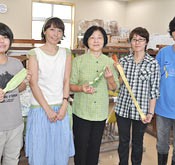
July 18, 2014 Ryukyu Shimpo
In an effort to promote the fascinating art of Uji (sugarcane)-dyeing nationwide, Yumiko Ishibashi, a designer and tailor living in Kyoto, has been creating a line of products. At-tracted to Uji-dyeing, which is a signature fabric-dying style of Tomigusuku City, Ishibashi has been working with the full support of the City’s Uji-dyeing Cooperative.
When she was a university student, Ishibashi became interested in Uji-dyeing after hear-ing her friend’s sister talk about it.
Recalling the past, Ishibashi said, “There are many sugarcane fields in Okinawa. I was sur-prised by its dyeing color, which was different from what I expected.”
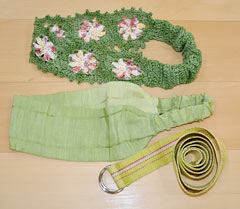
Uji-dyeing scrunchy and belt.
Ishibashi is in charge of design and sales at her own online shop “Mint Julep.” She said, “I like the cool image of
Uji-dyeing. I would like to design something that ladies can casually wear.”
Uji-dyeing has been used widely for products such as tablecloths and kariyushi shirts. However, Ishibashi makes fashion items for women such as casual skirts that are distinct from traditional Uji-dyeing products.
Taking Ishibashi’s suggestion, Chairperson of the Cooperative Etsuko Kakinohana said, “Uji-dyeing is a new craft. Making products with new styles will be good chance to pro-mote Uji-dyeing beyond Okinawa. Members were touched by Ishibashi’s passion.”
The Cooperative decided to support the production.
Eriko Irei, who will weave and knit Ishibashi’s products, said, “Although it was a new field I had not experienced, I appreciated the proposal. We would like to share ideas and make good products.”
Ichiko Okuhama and Akiko Takaesu will be in charge of dyeing.
Products include a skirt (11,000 yen), a scrunchy (5,000 yen), and a belt (7,000 yen). It takes one month from order to delivery.
For further details, call Ishibashi at 090 (3614) 8109.
(English translation by T&CT and Megumi Chibana)
Go to Japanese
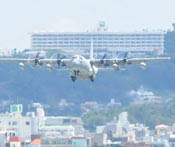
July 16, 2014 Ryukyu Shimpo
On July 15, the United States Marine Corps in Okinawa started moving 15 KC-130 aerial refuelling tankers to the Marine Corps Air Station Iwakuni in Yamaguchi prefecture from Futenma Air Station.
The first batch of the two aircraft left for Iwakuni on the same day.
The U.S. and Japanese governments plan to gradually move the aircraft to Iwakuni, and complete the transfer of all 15 aircraft by the end of August.
This is the first time the U.S. military has moved squadrons from Okinawa to the main island of Japan based on the agreement on the Realignment of U.S. Forces in Japan. However, the Marine Corps stated that they would continue to carry out training exercises with the aircraft in Okinawa, even after the redeployment.
Before the transfer, a ceremony was held in the Futenma Air Station. The Japanese and prefectural governments, Ginowan City government, and U.S.military personnel took part. Okinawa Vice Governor Kurayoshi Takara said, “The transfer clearly displays the U.S. and Japanese governments work on reducing the burden of military bases on Okinawa.”
With the transfer, the military will move about 800 of its personnel and their family members to Iwakuni.
Following the rape of a young girl by U.S. military personnel in 1995, the U.S. and Japanese governments agreed to reduce the burden of military bases on Okinawa. The redeployment is part of the plan stipulated in the Final Report of SACO (Special Action Committee on U.S.-Japan) and the agreement on the Realignment of U.S. Forces in 2006.
(English translation by T&CT)
Go to Japanese
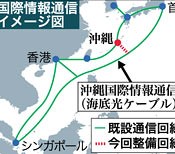
July 18, 2014 Ryukyu Shimpo
The Okinawa Prefectural Government chose Tokyo-based NTT Communications Corp to install an underwater cable connecting Okinawa, areas around Tokyo and Asian countries on July 17. With a vision to make Okinawa an information hub for Asia, the government will work on developing a new international communication network.
Through a high-speed network with large capacity and less exposure to earthquakes than other parts of Japan, the government will promote information industries such as server backup and content delivery services.
After acquiring materials, the company plans to install the underwater fiber optic cable, which will be laid in the Pacific Ocean. The prefectural government will help to pay a bil-lion yen of the construction cost.
The government plans to buy 20-year long-term rights to use the cable connecting Okina-wa, areas around Tokyo and Hong Kong, and Singapore at a cost of about 6.6 billion yen from the company.
The prefectural government plans to attract companies in and outside Japan by providing communication services at prices as low as areas around Tokyo.
The project will officially start next autumn.
Hitoshi Nakaema of the Okinawa Prefectural Government said, “As many IT companies tap into the Okinawan market, bringing an increase in employees, we would like to develop human resources and jobs in the prefecture.”
(English translation by T&CT)
Go to Japanese
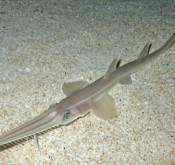
July 10, 2014 Ryukyu Shimpo
On May 7, 12 saw sharks were born at the Okinawa Churaumi Aquarium in Motobu. It was the first time that a saw shark became pregnant and succeeded in giving birth to its babies at the aquarium. This is a rare, successful case for aquariums around the world because it is said to be difficult to breed a saw shark in captivity. The baby sharks are about 36 centimeters in length. They are growing very well.
The aquarium staff members noticed the mother shark’s belly was swollen at the beginning of this year. The staff confirmed that the mother shark was pregnant by sonogram. They have isolated the pregnant shark from other fishes to take care of her. The aquarium is displaying four baby sharks of the 12 in the deep-sea tank. Visitors can see the baby sharks crawling on sand in the tank.
Hiroko Konno, a public relations staff member from the aquarium, said, “Many visitors pass by the deep-sea corner without knowing it because it is next to the main tank, called the Kuroshio Sea. But, there are many interesting species in the deep-sea tank. We hope the baby saw sharks will attract many visitors.”
(English translation by T&CT and Hitomi Shinzato)
Go to Japanese
July 15, 2014 Ryukyu Shimpo
The government has instructed the National Police Agency to strengthen security surrounding protests over seabed drilling in Henoko, Nago, where U.S. Marine Corps Air Station Futenma is due to be relocated. The Okinawa Prefectural Police plans to set up a public security investigation team at the headquarters soon. This team will carry out a security investigation in response to the situation in Henoko. The Okinawa Prefectural Police will establish a security force of 60-70 members this month, when the Okinawa Defense Bureau will set buoy lines and start drilling in the planned sea area.
The Okinawa Prefectural Police will form the team with not only members of the security department, it will also draw police officers from the detective and traffic departments as support personnel. It has not confirmed when the team will be finalised because exact timing of the drilling is not yet decided. A public security investigation team is a temporary organization set up when there is a possible risk in large-scale and specific security incidents such as civil resistance and demonstrations. They carry out investigations based on the Act on Special Measures Concerning Criminal Cases. In Okinawa, a public security investigation team was organized when the Osprey were moved to the Futenma Air Station.
The Okinawa Prefectural Police will establish what laws and regulations should be applied to suspects when major clashes occur between police and citizens who oppose the landfill. In the case of clashes, riot police will be stationed at the scene. The public security investigation team will respond to cases where someone is arrested or deemed a subject of investigation. Such a team is normally comprised only of members of the security department. However, when the expected large-scale movement of protesters takes place, members from other departments will join the team for support. Such special security measures have been taken before, such as when the Emperor visited Okinawa.
Keiji Furuya, the chairman of the national public safety commission, has said that the Okinawa Prefectural Police should not hesitate to respond firmly and harshly to activity deemed illegal according to evidence and public law. He said that he would advise the Okinawa Prefectural Police.
(English translation by T&CT)
Go to Japanese










 Webcam(Kokusai Street)
Webcam(Kokusai Street)


